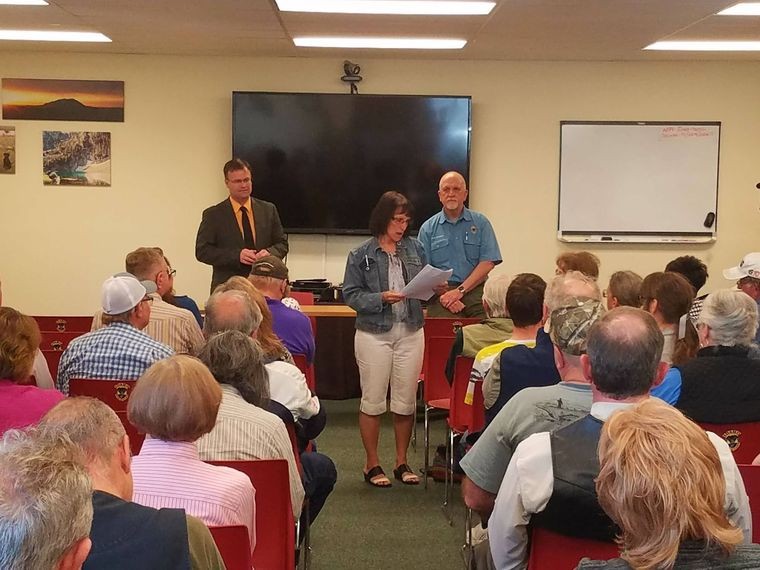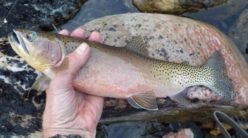POCATELLO — Large urban deer populations have caused quite the stir in south Pocatello in recent years, but finding a solution to that problem has proven to be complex.
Attempting to find a resolution that satisfies both advocates and detractors of what appears to be a growing population of fearless neighbors moving in, Pocatello and Idaho Fish and Game officials hosted a community forum on Wednesday, which allowed residents to voice concerns, support and solutions to this difficult predicament.
“This meeting was an attempt to gauge the interest of the public,” said Jim Mende, an environmental staff biologist for Idaho Fish and Game. “We really don’t have many solutions, but there are individuals who are being impacted by wildlife and some that, in general, enjoy seeing wildlife.”
Close to 100 people packed the regional office on Barton Road, and while many residents voiced their experiences, only a few had potential solutions to offer.
Denise England, who has lived on Country Club Drive for the past 35 years, said she never had a problem with handful of deer that frequented her property. That changed, however, when that handful more than tripled.
“Yes, I do love the deer,” England said. “Now, it’s not about whether we like them or not it’s not about numbers and it shouldn’t be about picking a side. It’s not a football team. Now that we have 20 deer I’ve started calling them the ‘Country Club 20.’ They are giving birth to more and they are not afraid of you.”
From destroying plants and shrubbery to mauling family pets, some residents believe that Fish and Game isn’t doing enough to curtail the rising population.
Others sided with the deer, attempting to ruminate on the fact that people living in the area moved into deer country fully knowing what to expect.
“I think this is ridiculous,” said Bud Smalley a resident in the Johnny Creek area since 1990. “Our homes are built inside of deer country. The deer population wax and weens, and right now it’s at an all-time high, but what the city needs to do is fine anybody who feeds the deer.”
Many of the residents have found solutions of their own including tall fences surrounding lawns and gardens and bark protectors around trees.
“I’ve lost hundreds of dollars from deer eating the plantings,” said resident Rebecca Hathaway. “I know they like roses so I spray with deer stopper, put fences around the shrubs and bark protectors around the trees. Sure, occasionally they will nip a bud or two but they can’t horn the trees or eat the plants, and so far, it works great.”
To further the discussion and find an answer to this problem, Idaho Fish and Game requested interested attendees to sign up for a urban deer committee task force.
“This task force is going to be instrumental in finding a solution,” Mende said. “It’s a smaller group that can help talk this problem out and will have equal representation including some folks that are for some type of control and others that just enjoy the wildlife.”
One potential discussion item, according to Mende, is considering some type of ordinance for people who are feeding the wildlife.
“We know that feeding the animals really exasperates the problem,” Mende said. “And municipalities that implement these ordinances really see a difference. But, again, looking for a solution it’s all about what the public believe is manageable. There is a myriad of ways to address this problem and it all hinges on the community’s interest and the city’s ability to tackle this problem.”
At this point, everything is on the table, Mende added.
Elsewhere across the country, city and county governments have implemented controlled bow hunts in city limits, or trapping programs that capture and relocate the deer to lesser populated areas.
“Some type of short-range weapon hunt is pretty untenable,” Mende said. “Some cities have tried specific groups that are empowered whether it’s off-duty law enforcement or Fish and Game officials but they aren’t always successful. And the idea of trapping and transporting animals in large numbers can result in 50 to 60 percent mortality. Then the question arises of where do you put them.”
Though it’s unknown whether the increasing populations is a result of damaged habitat from the 2012 Charlotte Fire or if the increase in deer-related accidents is attributed to the new South Valley Connector, but as one resident said, “over time, generations have taught us that it’s a lot easier for us to adjust to the wildlife than force the wildlife to adjust to us.”
“After the meeting, it’s obvious that people feel strongly about deer in Pocatello, one way or another,” said Pocatello Mayor Brian Blad. “There were many different ideas presented by residents that address the deer population and I look forward to hearing what recommendations the task force will have as we go forward.”



